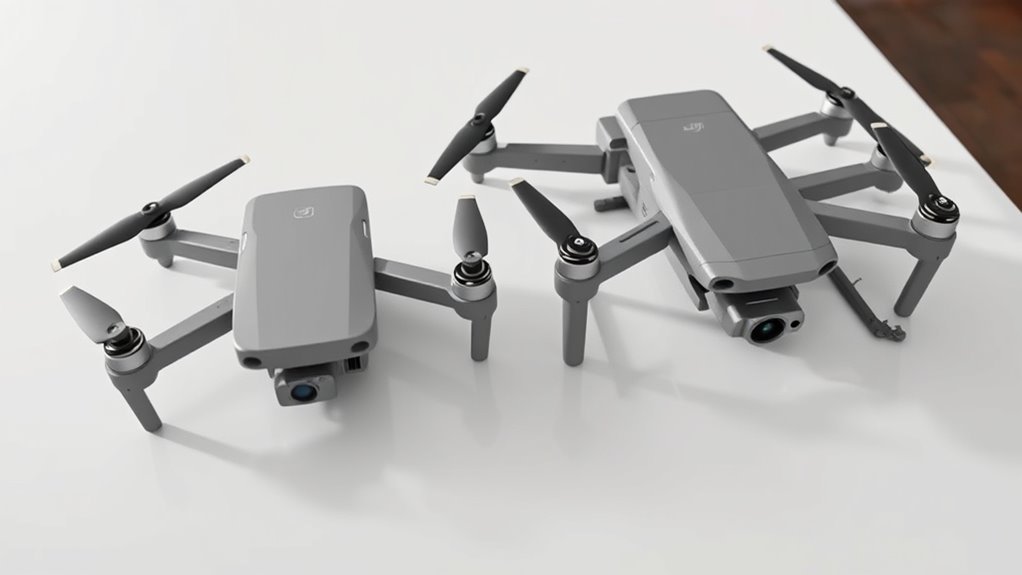When you’re comparing the Lucid Sanitization Drone and the DJI Mavic 3 Enterprise, you’ll see the Lucid’s specialized cleaning camera excels in precise disinfection tasks, like hospital sanitization, with its durable frame, high-resolution sensors, and efficient spray systems for minimal waste. In contrast, the DJI’s modular enterprise camera offers versatile imaging and agile maneuverability for broader applications, such as industrial inspections. It’s about your needs: focused cleaning efficiency versus adaptable performance. Explore key specs and user insights further for a complete picture.
Key Specifications Comparison
While the Lucid Sanitization Drone and DJI Mavic 3 Enterprise share some core drone features, their key specifications diverge in ways that highlight their specialized uses. You might find the Lucid’s drone design prioritizes durability and efficiency for sanitization, featuring a lightweight, enclosed frame that enhances stability in confined areas, allowing you greater freedom to operate autonomously. In contrast, the DJI Mavic 3 Enterprise offers a modular drone design with expandable components, giving you the flexibility to adapt for diverse professional needs without added bulk.
When examining camera features, the Lucid Sanitization Drone equips you with high-resolution sensors tailored for precise monitoring, ensuring accurate detection during tasks. Meanwhile, the DJI model includes advanced multi-lens systems, providing you with versatile imaging options like wide-angle views and enhanced low-light capabilities. These differences empower your choices, aligning specifications with your pursuit of independent, effective drone applications. Ultimately, you decide based on whether you value specialized robustness or adaptable versatility. Furthermore, the real-time monitoring capabilities of Lucid’s cameras enhance operational efficiency, making them particularly advantageous for industrial cleaning tasks.
Performance and Capabilities
The performance of the Lucid Sanitization Drone focuses on efficient sanitization tasks, with its robust design enabling longer flight times and precise autonomous operations that suit routine disinfection missions. You’ll find its cleaning efficiency stands out, delivering thorough disinfection in hard-to-reach areas through optimized spray systems and sensors that minimize waste and maximize coverage. This autonomy lets you operate freely, reducing manual intervention for safer, more independent workflows. Additionally, the drone’s capabilities can be enhanced by utilizing real-time data to monitor sanitization effectiveness and optimize future missions.
In contrast, the DJI Mavic 3 Enterprise excels in aerial maneuverability, offering agile flight controls and modular camera setups for versatile enterprise applications. You can appreciate how its quick responsiveness and obstacle avoidance enhance performance in dynamic environments, though it lacks the Lucid’s specialized sanitization focus. When weighing these capabilities, your choice hinges on prioritizing cleaning efficiency versus superior maneuverability for unfettered aerial freedom.
Value and Recommendations
When evaluating the value of the Lucid Sanitization Drone versus the DJI Mavic 3 Enterprise, you’ll find that cost-effectiveness hinges on your specific needs—such as prioritizing specialized disinfection tools over versatile aerial features. A detailed cost analysis shows the Lucid offers lower upfront costs for niche sanitization tasks, making it ideal if you’re focused on efficient, targeted cleaning without breaking the bank. In contrast, the DJI’s higher price reflects its modular versatility, appealing if you seek broader aerial applications that enhance your operational freedom.
User feedback highlights the Lucid’s reliability in disinfection scenarios, with users praising its straightforward setup and effectiveness, though some note limited expandability. The DJI receives acclaim for adaptability and superior imaging, but critics mention its complexity. Ultimately, we recommend the Lucid if cost analysis aligns with your disinfection priorities, empowering you to maintain autonomy in specialized environments; opt for the DJI when versatility frees you for diverse missions. Additionally, leveraging precision crop monitoring can enhance operational efficiency in agricultural settings, offering insights that inform cleaning strategies.
Frequently Asked Questions
What Is the Return Policy for These Drones?
Imagine you’re a bird soaring freely, only to realize your flight path needs adjustment—like returning to the nest for safety. When considering drones, you’ll want a solid return policy comparison and warranty details. For many models, it’s 30 days for returns with original packaging, while warranties vary from 1 to 2 years against defects. This empowers you to choose freely, minimizing risks and ensuring your aerial adventures remain unobstructed. Stay informed to fly with confidence.
Do They Include a Carrying Case?
You’re wondering if drones come with a carrying case. When evaluating carrying case features, you’ll notice variations that impact drone portability comparison. For instance, some models include durable, compact cases for easy transport, enhancing your freedom to fly anywhere without hassle. Analytically, the Lucid Sanitization Drone offers a basic case, while the DJI Mavic 3 Enterprise provides a more modular one, aiding better mobility for your adventures.
How to Contact Technical Support?
If you’re seeking technical assistance, you’ll find various support channels readily available to help you resolve issues efficiently. Start by visiting the manufacturer’s website for options like live chat, email forms, or phone lines. You might also explore community forums for peer advice. This empowers you to choose the most convenient method, ensuring your freedom to troubleshoot on your own terms and maintain control over your technical needs. Remember, providing detailed device info speeds things up.
Are Software Updates Free?
You might compare software updates to a key releasing new horizons, keeping your devices fresh and efficient. When it comes to software upgrades, they’re often free, but you’ll want to scrutinize maintenance costs that could sneak in. Analytically, many providers offer these at no charge to enhance security and functionality, empowering you with cost-free independence and minimal financial ties for ongoing freedom.
What Languages Are Supported in the Interface?
You’ll find that the interface languages supported vary by drone model, but many offer robust multilingual support to enhance your operational freedom. For instance, DJI’s systems typically include English, Chinese, Spanish, French, German, and more, allowing you to navigate seamlessly in your preferred language. This analytical feature promotes accessibility, ensuring you’re not limited by language barriers in your missions. Lucid drones might mirror this, but always check specifics for full compatibility.

